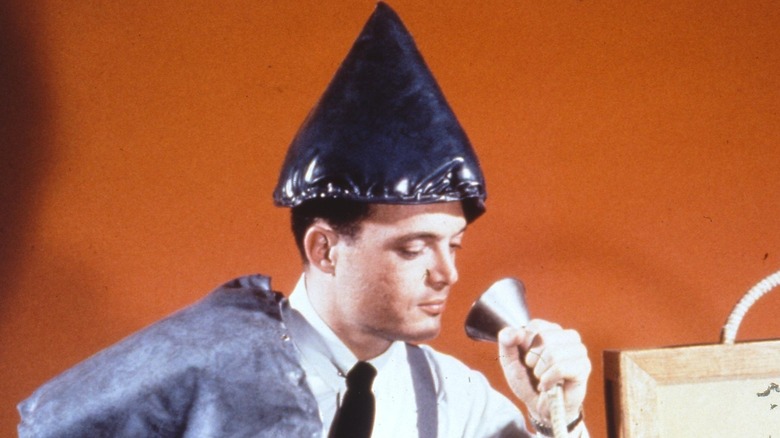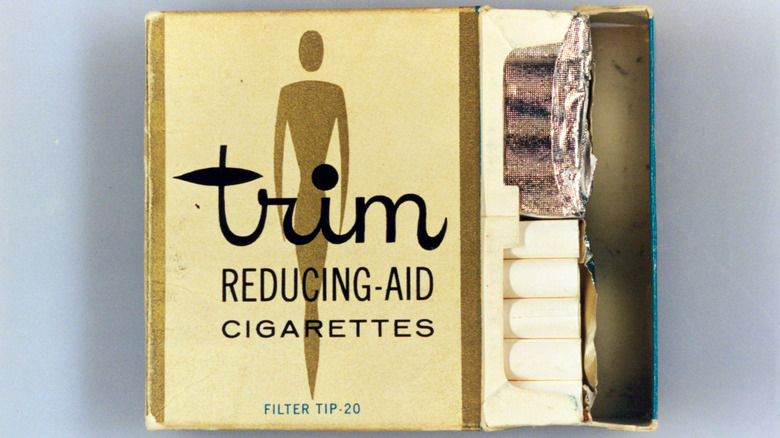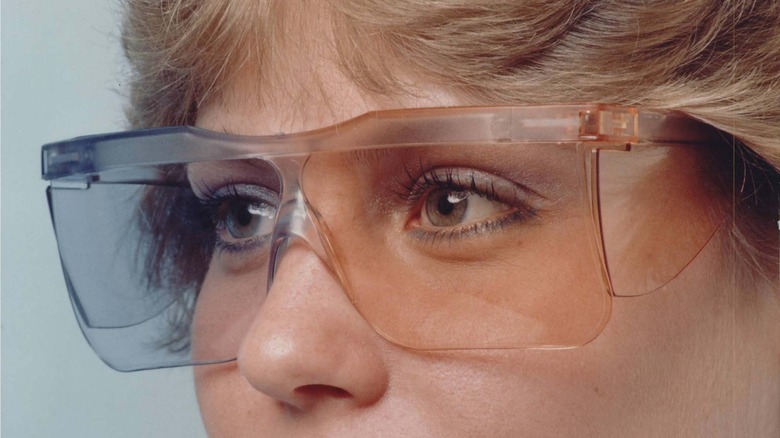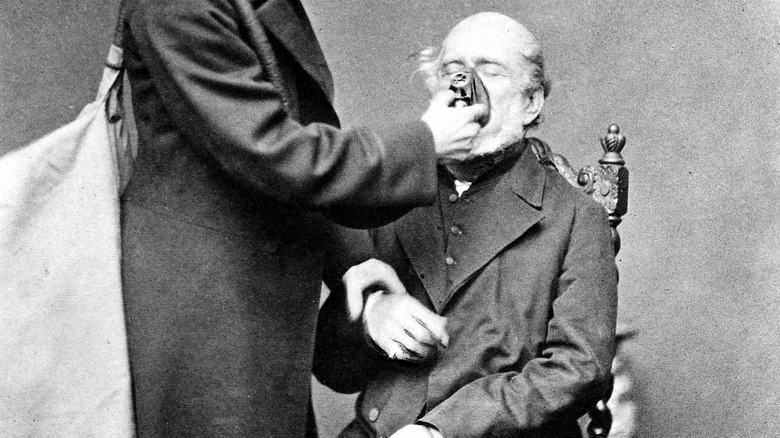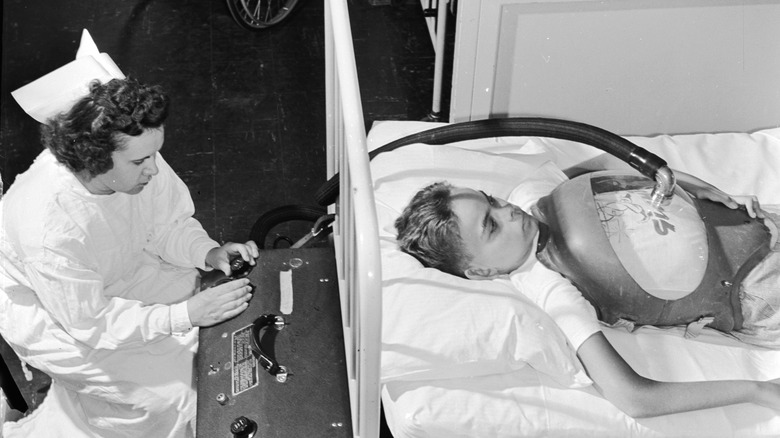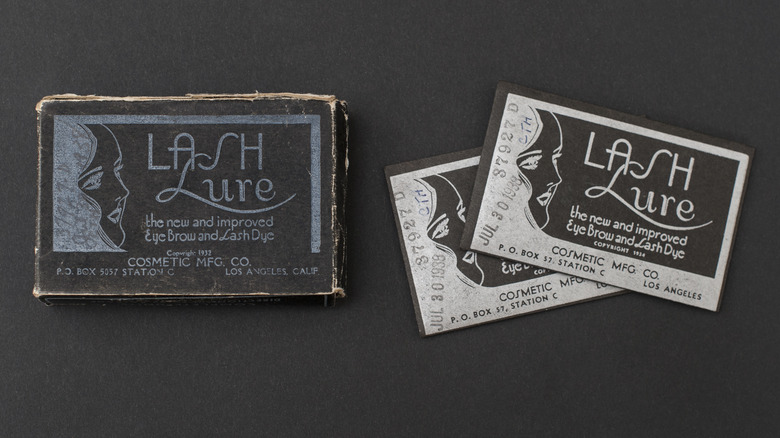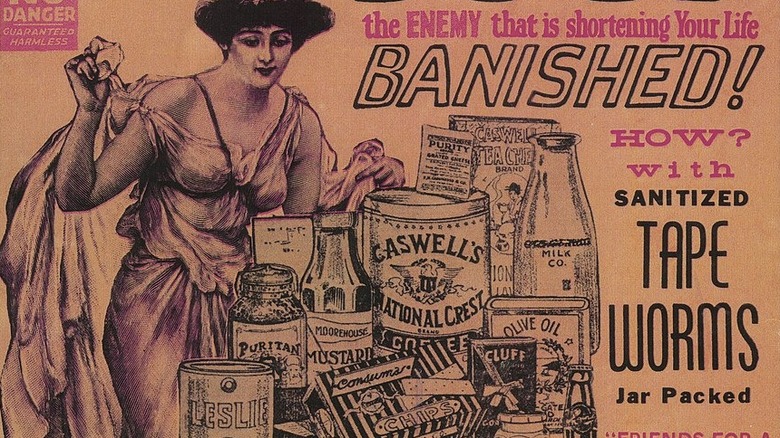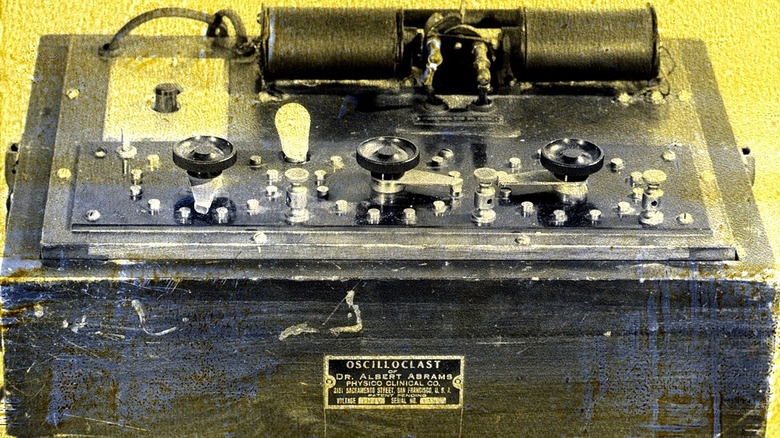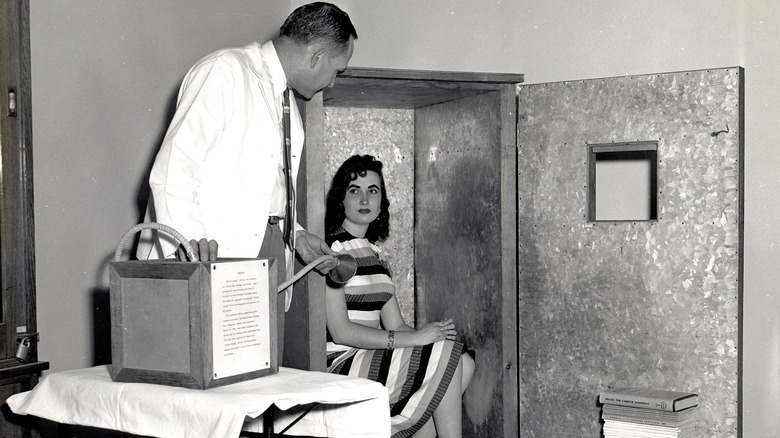Strange Health Products From The Past You Don't See Anymore
Most of us can agree that there are still huge gaps when it comes to modern medicine. We are anxiously awaiting a cure for cancer after all. Despite these few lacking lifesavers, western medicine and the health landscape at large have made huge strides in this arena. But with those advances came a lot of trial and error. Many medicinal treatments and health tonics — some from less than 100 years ago — are downright frightening!
In addition to the strange remedies, torturous-looking devices were also sold to the general public to cure myriad ailments (via Stat News). While we can think of a few medieval medical procedures and some unusual health aides that are still used today, many respected administrations have stepped in to help keep the general public safe.
We've lined up some of the most fascinating, repulsive, and straight-up wild health and medical products from the past. Though some have been rebranded and popularized for new reasons, you won't really see any of these at your local Walgreens. We can thank the FDA for that.
Trim Reducing Aid-Cigarettes
In 1958, the FDA nabbed nearly 27,000 packs of Trim Reducing-Aid Cigarettes after discovering the lies behind the marketing. The makers of these cigarettes claimed that smoking at least three of their specific cigarettes per day could initiate significant weight loss. Yes, they claimed that their cigarettes were healthy, and by smoking them you could lose 20 pounds in eight weeks (via FDA). The label claimed that the cigarettes were a natural appetite suppressant and worked by drying out the mouth. A newspaper ad from the time claimed the cigarettes were backed with "successful clinical trials" and were a "scientifically proven reducing aid."
This may come as a shock, but Trim Reducing-Aid cigarettes didn't live up to their claims. And they were never "absolutely harmless" as the manufacturer said they were (per Insider). While tobacco and cigarettes have a fascinating history and this harmful gimmick is indeed interesting, we shudder to think about the poor men and women chainsmoking their way through the 1950s in hopes of shedding some weight.
Vision-Dieter glasses
Vision-Dieter glasses came to be in the 1970s and were marketed as an easy way to shed a few pounds. An opportunistic optometrist from Arkansas came up with the idea for Vision-Dieters, and the idea caught on. He claimed that by employing "secret European color technology," the colored lenses could help curb your appetite and reduce your cravings for food (via FDA). He claimed that you would endure slight confusion in your subconscious by wearing them for only two hours a day. That, he said, could help someone refuse to eat something that they didn't want to eat (per Quack Watch).
If this sounds like a scam and a half to you, you're right. The FDA became aware that a man was selling glasses with colored lenses backed by false claims. They swiftly seized the Vision-Dieters. And "since a claimant did not come forward, the case did not go to court and most of the glasses were destroyed," the FDA revealed.
The Revigator Water Jar
It is honestly so surprising that anyone lived past the 1920s and 1930s. Yet another incredibly harmful health scam being sold back in those days was called the Revigator Water Jar. The Revigator essentially looked like a ceramic water jug with a spout at the bottom, according to the National Institute of Standards and Technology (NIST). The Revigator was lined with carnotite ore clay, which released radon into the water inside the jug. As the clay began to decay, radium would leach into the water and then into the system of whoever drank it.
Many of these radioactive jugs were sold by the Radium Ore Revigator Company under false claims. Like many other inventors at the time, the company was simply trying to capitalize on newfound radioactive technologies. Long story short: This company was selling a water jug that bled arsenic, lead, uranium, and vanadium into drinking water. They claimed this imitation spa water could "remove cellular poisons" (via NIST).
Chloroform inhalers
In case you didn't know, chloroform has anesthetic properties. Chloroform is a colorless, nonflammable liquid thicker than water and has an ether-like scent (via Britannica). In the mid-1840s, doctor James Simpson of Scotland discovered chloroform and created inhalers to administer it to surgical patients, according to National Museums Scotland. Chloroform inhalers were born out of necessity, for better or for worse. Before their inception, surgical patients needed to be knocked out, drunk, or physically held down in order for surgery to be performed (via National Museums Scotland).
Many dentists and doctors were experimenting with anesthetics at the time of chloroform's discovery. They had been using ether, which quickly became chloroform's main rival. These days, though, healthier, safer alternatives exist. Chloroform was officially pronounced dead in 1974 due to the health risks it posed. But many people in the medical community still respect the discoveries made by Dr. James Simpson (via ScienceDirect).
Corn Flakes
Yes, you read that right. Corn Flakes were the face of an anti-masturbation campaign spearheaded by Dr. John Harvey Kellogg. Kellogg believed that sex was at the root of all evil, so he abstained and created a crusade to quell other's sexuality as well (via Mental Floss).
Kellogg became one of the first healthy eating icons, though this came from an arguably strange place. He believed that abstaining from pleasurable foods, such as sweet or spicy treats, was the key to a healthy life. Kellogg was convinced that eating bland, tasteless, bowel-moving foods would lead to a virtuous life, explained History. He accidentally created wheat flakes, corn flakes' predecessor, as a breakfast food to serve at the Battle Creek Sanitarium. Kellogg took the clean living moral of the Seventh Day Adventist Church and, uh, expanded on it. But as we now know, bland, fibrous foods do not "cure" sexual desire. Plus, many years later Corn Flakes gave way to sugary, not-bland Frosted Flakes (and we're not mad about it because they are gr-r-reat).
The iron lung
The iron lung was a great medical device that set the stage for others to come. However, iron lungs are as odd as they were useful. They were first used in 1928 and offered breathing support for patients with various ailments. The main successes were seen in paralyzed polio patients, according to the College of Physicians of Philadelphia's History of Vaccines resource. In many patients, polio caused paralysis of the intercostal muscles and diaphragm.
According to History of Vaccines, an iron lung was a large, sealed, tube-like structure. The patient reclined in the tube with a seal made of rubber around their neck. The head remained free while the body was encapsulated in the tube. Due to the variance in air pressure, the air was forced in and out of the lungs. This mimicked the muscular movements of breathing.
Iron lungs were widely used throughout the 1930s and well into the 1950s, saving thousands of polio patients. Iron lungs stopped being used once ventilators were invented and a safe and effective polio vaccine became widely available (Science Museum).
The 'Magic Spike'
Amid the chaos of the 1940s, the Vrillium Tube, or "Magic Spike," was born (via FDA). It was a two-inch stick that contained barium chloride. The manufacturers of these tubes claimed that the barium chloride was "healing radioactive alien rays," which obviously sounds promising. Manufacturers claimed consumers who wore their vrillium tubes around their necks would have any and all of their illnesses cured.
In reality, the FDA states that barium chloride is a powerful horse laxative that does not have any influence when worn as an accessory. Additionally, there is one case of a father suing the company over his son's death. His diabetic son opted out of his insulin injections under the impression that the vrillium tube would help cure his diabetes. "In its ruling, the Court admonished the officers of the company for perpetrating 'a gross fraud on the public,' that 'discourages and prevents those who use it from seeking proper medical treatment and the results of such neglect are often fatal,'" the FDA revealed.
Lash Lure
Lash Lure is yet another toxic product peddled in the 1930s. As 1938 was the first year that cosmetics came under federal scrutiny and regulation, according to Smithsonian, 1933's Lash Lure was able to hit the markets without a hitch. It appealed to women because it promised to deliver a permanently made-up look. It dyed the eyelashes darker using aniline dye. However, the dye contained a chemical known as p-phenylenediamine.
P-phenylenediamine use left some users with abscesses and ulcers on their faces and eyes. Others experienced an even more alarming side effect: blindness, as the book "Science, Medicine, and Animals" revealed (via National Academies Press). Lash Lure was the first product forcibly removed by the FDA after passing the Food, Drug, and Cosmetic Act in the late 1930s. In fact, Lash Lure was one of the products that actually "led to the passage of the Food, Drug, and Cosmetic Act of 1938," the book confirmed.
Tape worm diets
The "no ill effects" lettering across the antiquated ad for easy-to-swallow tapeworms is one of the wildest old-timey health products we have stumbled across. Yes, tapeworms were jarred and sold as a means of weight loss (via FDA). However, they were not sold in the way that fad diets are marketed today.
At the turn of the 20th century, tapeworms were sold to those who could afford to "Eat! Eat! Eat!" The tapeworm diet promised that you could eat whatever you wanted and still stay thin. To this day, this science technically holds true, according to Healthline. If you ingest a tapeworm, you are eating a parasite that will consume all of the food you ingest. This will prevent you from absorbing it, thrusting you into a calorie deficit and thus leading to weight loss. Of course, consuming tapeworms is super risky, and experts insist that this was an absolutely terrible fad (per Healthline).
Consuming tapeworms or their eggs can lead to serious health problems. These issues include blockages of bile ducts, neurological problems, and even death. So, sure, you could lose weight while gorging on donuts if you opt for the tapeworm diet. But don't.
Oscilloclast
The Oscilloclast is a device we sure could use in medicine — if it weren't so epically flawed. It was created by a San Francisco-based doctor named Albert Abrams. His hypothesis was that disease represented an imbalance in electronic harmony within the body, according to Segen's Medical Dictionary. He believed that all diseases were born of this imbalance and thus created a machine that could allegedly repair these ailments. He claimed that the Oscilloclast refed electronic waves into the body, which lead to the rebalancing of biological systems (via FDA).
Shortly after its rise to fame, doctors submitted biological samples to be tested within the Oscilloclast by the FDA. The FDA ended up prosecuting Abrams over false health claims. As it turns out, the device could not distinguish between colored water, human blood from a live body, or human blood from a corpse, per the medical dictionary. Yes, it was unfortunately a complete dud.
The Hagi Pipe
Hang on to your hats here, folks, because this strange health product is a total brain spinner. The ads for the Hagi Pipe states that it is the "gospel to all smoker," which is a pretty attractive statement (via FDA). And what, you may ask, were these slender tobacco pipes intended to do?
The Hagi Pipe was marketed as a way to erase the negative effects of smoking. It came to be in the same era as Trim Reducing-Aid Cigarettes when laypeople were easily convinced that inhaling chemicals was beneficial. The marketing efforts were simple and effective. They claimed that smoking a Hagi Pipe could prevent lung cancer. Or rather, "prevent lung cancer from smoking."
Eventually, these claims were challenged. "Commissioner George Larrick chose the Hagi Pipe as an example of why FDA needed funds to continue its accelerated oversight of health fraud during a 1960 congressional appropriation hearing," the FDA revealed.
Atoxyl
Pierre Antoine Béchamp created atoxyl, a frightening-sounding drug, in 1859. He concocted it by inflicting a reaction between arsenic and aniline, according to a report published in Medicinal Organometallic Chemistry. According to the Centers for Disease Control and Prevention (CDC), aniline is a semi-toxic substance that is still widely used today. Arsenic, however, is highly and aggressively toxic.
Despite the fact that we now know arsenic to be highly dangerous, it was used medicinally for centuries. Doctors used it to treat fevers, headaches, syphilis, and many blood diseases, the report highlighted. Can you imagine?! Going to the doctor for a run-of-the-mill headache and coming home with a prescription for arsenic. In the wise words of Bad Religion and many others, "sometimes truth is stranger than fiction."
However, despite arsenic being poisonous, the journal revealed that it did have favorable effects when treating some of the ailments listed above. Arsenic-based medications were discontinued for regular use in the 1990s. That said, an arsenic-containing medication was reintroduced in 2003 and is still being used to treat some highly specific blood diseases.
Orgone Energy Accumulator
Many of the creators of strange health products faced legal repercussions based on the fallacies in their marketing and logic. Many were sued by the FDA and innocent, albeit gullible, consumers. The chaotic mastermind behind the Orgone Energy Accumulator, Wilhelm Reich, met a much different fate. He was actually sentenced to two years in prison after disregarding warnings to stop selling his product by the FDA, reported The Washington Post. Reich would not complete his stint, as he suffered a fatal heart attack in 1957, just nine months into his sentence.
Reich believed in "orgone." He called this the universal healing force and was determined to share this power with the world. He believed that if he could bind up a certain amount of orgone and administer it to people, he could cure various diseases.
The notion behind the Orgone Energy Accumulator lives on, according to Wired. Some say that orgone is similar to unseen energy or "chi." But most people, experts included, deduced that Reich's Orgone Energy Accumulator was rooted in fraud and fallacy. Most people now firmly believe that orgone is a fictional substance (via Popular Mechanics).
Banbar
As most people know, insulin is the accepted treatment for diabetes. This fact was discovered and put to use around the 1920s. However, that did not discourage the creators of Banbar from making their big move (via FDA).
Banbar was sold as a drug that was alleged to treat diabetes. It was marketed as a drug that could, in fact, replace the use of insulin. Many diabetics chose to switch from using insulin to manage their disease to using Banbar. Unfortunately, this choice led to fatal consequences for many of these consumers. The wildest part about Banbar is that the FDA attempted to sue them and lost, as the FDA detailed.
Thankfully, Banbar is no longer able to be sold and insulin remains the gold standard for diabetes management and treatment (via Mayo Clinic). "By choosing an insulin regimen that fits your needs and lifestyle, you can prevent diabetes complications and lead an active, healthy life," the organization confirmed.
